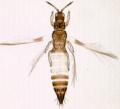Anaphothrips sudanensis
Recognition data
Distinguishing features
Female macropterous or micropterous; body bicoloured, mainly dark brown but with abdominal segments III–V (or VI) yellow, also antennal segments III–IV; fore wing distal half pale but with dark cross band medially. Antennae 8-segmented, III & IV each with short forked sensorium. Head and pronotum with no long setae. Metanotum reticulate with median pair of setae well behind anterior margin; campaniform sensilla present or absent. Fore wing when developed with veinal setae shorter than half of wing width, first vein with 3 setae on distal half, second vein with about 6 equally spaced setae; clavus with 4–5 veinal setae and one seta near base. Abdominal tergites with no lines of sculpture medially, VIII with complete posteromarginal comb of long slender microtrichia. Sternite VII with median pair of setae arising in front of posterior margin. Male similar to micropterous female but legs paler and pterothorax usually largely yellow; tergite IX with 2 pairs of stout thorn-like setae medially; sternites III–VIII with large C-shaped pore plate.
Variation
Bicoloured males occur in Australia, but yellow males have been studied from India and northern Africa. In Japan, seven colour varieties are recorded (five female, two male)(Nakao et al., 2001).
Related and similar species
About 80 species from around the world are currently placed in the genus Anaphothrips, of which 17 are known from North America, all living on grasses (Nakahara, 1995), and 43 from Australia, mostly living on plants other than grasses (Mound & Masumoto, 2009). The species are structurally very similar to each other, although A. sudanensis is unusual in having strongly bicoloured females.
Taxonomic data
Current valid name
- Anaphothrips sudanensis Trybom
Original name and synonyms
- Anaphothrips sudanensis Trybom, 1911: 1
- Euthrips flavicinctus Karny, 1912: 115
- Euthrips (Anaphothrips) alternans Bagnall, 1913: 291
- Neophysopus medioflavus Schmutz, 1913: 1017
- Euthrips citricinctus Bagnall, 1919: 270
- Anaphothrips speciosus Hood, 1919: 76
- Anaphothrips transvaalensis Faure, 1925: 150
- Anaphothrips bicinctus Hood, 1925: 50
- Anaphothrips bicolor Morgan, 1925: 4
- Anaphothrips flavicinctus f. brachyptera Priesner, 1935: 355
- Anaphothrips (Neophysopus) piercei Moulton, 1936: 265
Family placement
Thripidae, Thripinae
Biological data
Life history
Feeding and breeding only on leaves, commonly in the leaf axils.
Host plants
Recorded from many different Poaceae, including Saccharum.
Tospoviruses vectored
None
Crop damage
Feeding on young leaves can lead to streaks as the leaves mature.
Distribution data
Area of origin
Presumably Old World tropics.
Distribution
This species is widespread across the Old World tropics and subtropics from north Africa to Australia. It is also common in the territories around the Carribean, including Puerto Rico, and is a potential immigrant to California.





